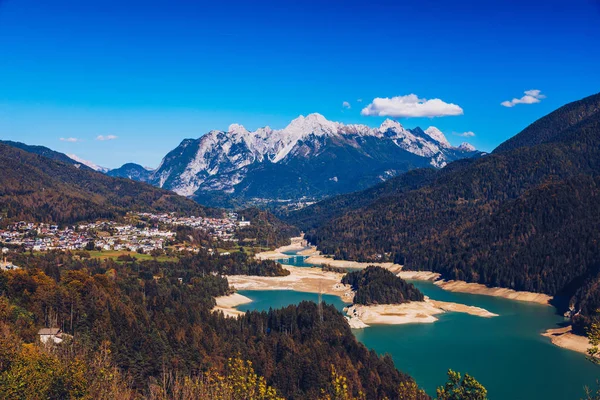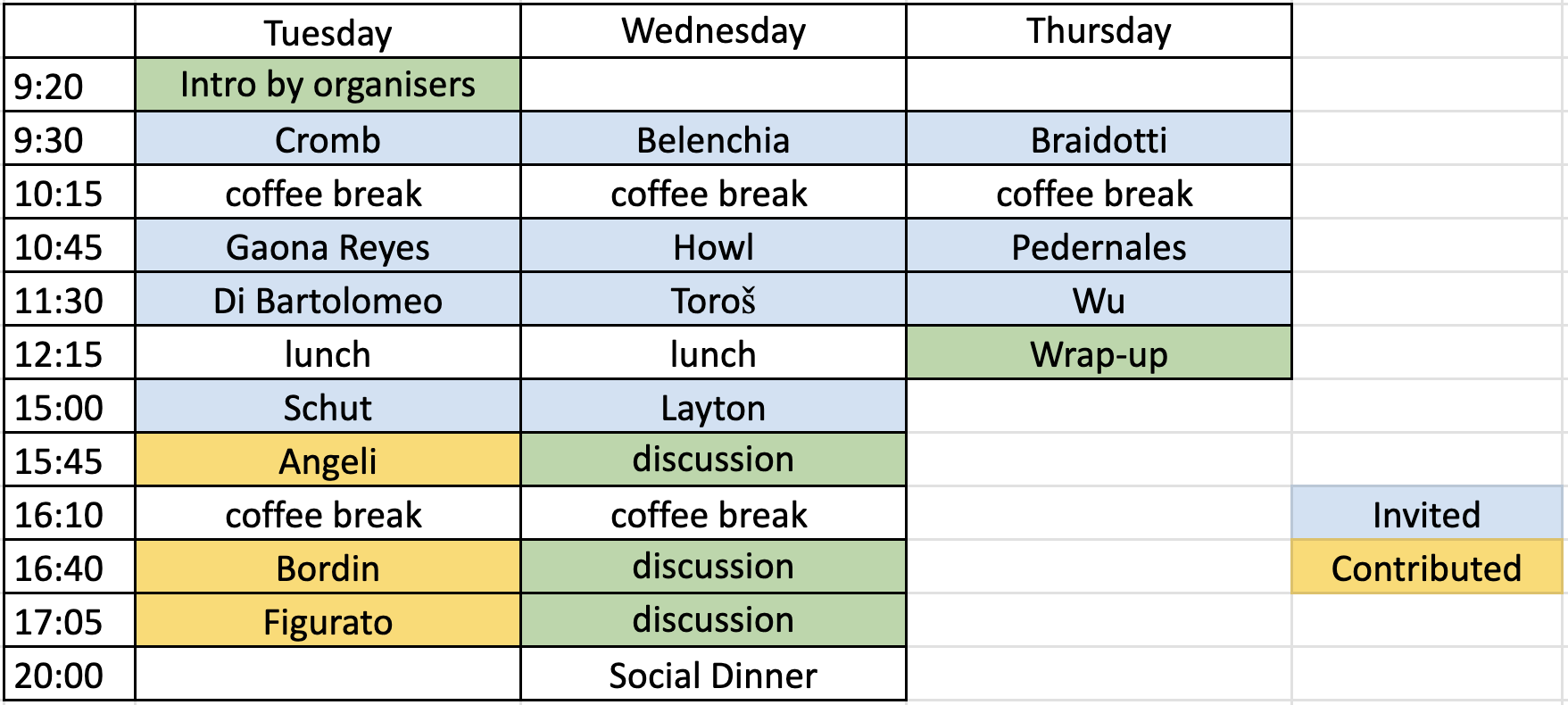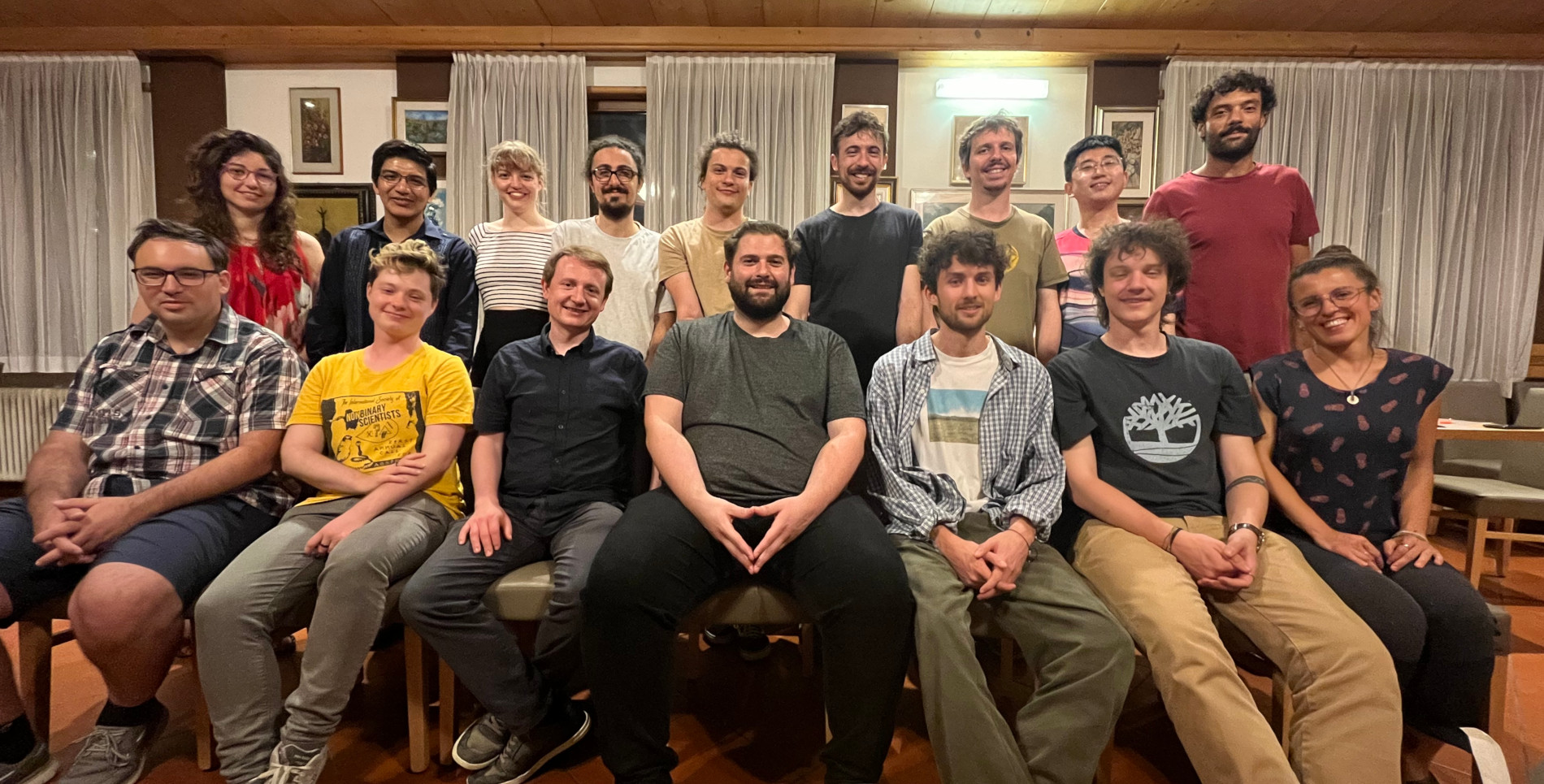A look at the interface between gravity and quantum theory

The workshop will gather young researchers working in topics at the interface between gravity and quantum mechanics. PhD students and PostDocs will be given the opportunity to present their research activity and interact with their colleagues, share motivations, techniques and perspectives, in a friendly and informal environment. A great amount of time will be dedicated to discussions and perspectives. The workshop is limited to a small number of attendee. If you are interested to attend, please consider registering as soon as possible. If your schedule changes and you are not able to attend after having registered, please let us know as soon as possible.
Please note, for those not giving an invited talk, it is mandatory to present a contributed (shorter) talk and, thus, to submit an abstract.
Speakers
Oliviero Angeli (University of Trieste)
Alessio Belenchia (University of Tubingen)
Matteo Bordin (Queen’s University Belfast)
Maria Chiara Braidotti (University of Glasgow)
Marion Cromb (University of Southampton)
Giovanni Di Bartolomeo (University of Trieste)
Laria Figurato (University of Trieste)
José Luis Gaona Reyes (University of Trieste)
Richard Howl (University of London)
Isaac Layton (University College London)
Julen Simon Pedernales (Ulm University)
Martine Schut (University of Groningen)
Marko Toroš (University of Glasgow)
Meng-Zhi Wu (University of Groningen)
Angelo Bassi – University of Trieste, Italy
Matteo Carlesso – Queen’s University Belfast, UK
Sandro Donadi – Queen’s University Belfast

Abstracts booklet
Oliviero Angeli (University of Trieste, Italy)
Title: Noises from quantized gravitational waves
The question of the nature of gravity -classical or quantum- is at the center of modern physics. However, there is no direct evidence that gravity should be quantized. Recently, a new indirect experimental signature of the quantization of gravity has been proposed: a quantized gravitational wave induces an additional stochastic noise of quantum origin in the geodesic deviation equation. Moreover, the spectrum of the noise is completely specified by the quantum state of the gravitational field and might be detectable in gravitational wave observatories. I will review the technique to obtain the Langevin-like geodesic deviation equation and discuss its phenomenology. Finally, I will briefly discuss the possible implications of this discussed framework for the gravitational decoherence literature.
Alessio Belenchia (University of Tubingen, Germany)
Title: Looking for the quantum nature of gravity in the lab
Recent years have seen a growing interest in the possibility of testing the quantum nature of gravity with tabletop experiments. In this talk, I review some (theoretical) arguments in favour of these attempts but also critical issues that need to be tackled in future endeavours.
Matteo Bordin (Queen’s University Belfast, UK)
Title: Gravitational Decoherence models: an overlook and the case of a stochastic background field
The field of Gravitational Decoherence has known a rapid spread in the last decades. Many models predicting it have been studied, both relying on different hypotheses and obtaining different, and sometimes contradicting, results. In the beginning of this talk a brief review of these models is provided, together with a recent one, which manage to encompass them all under very general assumption and hypotheses (https://arxiv.org/pdf/1905.01121.pdf). After an overview of the key steps in the derivation of the latter, and how it recovers the other models under appropriate assumptions, the talk concludes with a theoretical prediction on gravitationally-induced decoherence from the Stochastic Gravitational Waves Background.
Maria Chiara Braidotti (University of Glasgow, UK)
Title: Utilizing mechanical rotation as a means of wave amplification
Rotation, a form of non-inertial motion, plays a vital role both in the universe and in our everyday lives, making it a central aspect of fundamental physics theories like general relativity and quantum mechanics. However, the effects of mechanical rotation on wave scattering continue to intrigue and challenge us. In this presentation, I will show experimental measurements of the Zel’dovich effect, a 50-year-old prediction that electromagnetic waves scattered by a rotating metallic body can be amplified. Furthermore, I will elucidate the connection between this effect and its relevance to current energy technology.
Marion Cromb (University of Southampton, UK)
Title: Beyond the binary: a “revolutionary” approach
Trying to understand how quantum mechanics and general relativity might mesh together, or what physics will supersede them both is one of the biggest fundamental problems in physics. Trying to experimentally test these two theories face-on and simultaneously is extremely technically challenging, as they usually deal with extremely binary opposing physical regimes. There’s perhaps an easier side-attack, inspired by the general relativistic equivalence of curved spacetime and non-inertial reference frames. Non-inertial frames are much easier to create in a lab, and the simplest uniformly accelerating frame to keep in the lab is arguably a rotating one, as it will stay in the same place indefinitely. New insights into fundamental and quantum physics involving rotating systems should provide insights into the same physics in curved spacetimes. I will present my experimental work involving rotating frames. One project, how a rotating frame affects the manifestation of quantum entanglement between two photons. Another project, how acoustic waves with angular momentum are amplified through interaction with a rotating absorber, due to negative frequencies in the rotating frame.
Giovanni Di Bartolomeo (University of Trieste, Italy)
Title: Gravity as a classical channel and its dissipative generalization
Recent models formulated Tilloy and Diosi describe the gravitational interaction through a continuous measurement and feedback protocol. In such a way, although gravity is ultimately treated as classical, they can reconstruct the proper quantum gravitational interaction at the level of the master equation for the statistical operator. Following this procedure, the price to pay is the presence of decoherence effects leading to an asymptotic energy divergence. One does not expect the latter in isolated systems. For this reason a dissipative generalization of the model is needed. In this generalization, in the long time limit, the system thermalizes to an effective finite temperature. In the talk I will analyze and compare possible ansätze to build such a dissipative extension.
Laria Figurato (University of Trieste, Italy)
Title: On the testability of the Károlyházy model
The possibility that gravity is fundamentally classical and that it induces decoherence in space has been often considered in literature. One of the first attempts in this direction is a model put forward by Ka ́rolyha ́zy, which relates fundamental limitation in the ability to perform a measurement using a quantum probe to the existence of fluctuations of the spacetime metric responsible for decoherence. Due to the interaction of charged particles with this fluctuating spacetime, the model predicts a continuous emission of radiation; Dio ́si and Luka ́cs showed that the radiation emission rate is in contradiction with experimental observations, hence ruling out the model. We note that, in deriving his model, K ́arolyha ́zy makes an additional hypothesis by assuming that the spacetime fluctuation satisfy a wave equation. In this paper we reconsider the model by relaxing this assumption and studying more general correlation functions of the spacetime fluctuations, only imposing symmetry under space and time translations, and time reflection. We compute the constraints the correlation function must fulfill in order to be compatible with Ka ́rolyha ́zy fundamental idea and with current experimental bounds. While correlation functions factorized in space and time, like those used in standard spontaneous wave function collapse models, are ruled out when employed in this extended K ́arolyha ́zy model, we show that there are forms of the correlation function which are compatible with all relevant constraints.
José Luis Gaona Reyes (University of Trieste, Italy)
Title: Recovering gravity through continuous measurements
I will describe some models which implement Newtonian gravity through a series of Gaussian continuous measurements and Markovian feedback. I will consider proposals which implement a linearized version of Newtonian gravity, and compare them with models which allow to consider the full interaction. I will argue that one of these models, due to Tilloy and Diósi, is under simple conditions, the most natural framework to implement Newtonian gravity through continuous measurements and feedback.
Richard Howl (University of London, UK)
Title: Entanglement through gravity provides strong evidence of quantum gravity
In 1957, Feynman presented a revolutionary thought experiment for how we could test if gravity is quantum or fundamentally classical. Several decades later, due to rapid progress in quantum experiments, this thought experiment could be close to a reality. Recently, it has been argued that Feynman’s idea can be understood as testing whether two or more masses can become entangled through their gravitational interaction. If they can, then, according to a theorem in quantum information theory – local operations and classical communication (LOCC) cannot create entanglement – and its generalizations, this would teach us that gravity must be quantum, not classical. However, a few papers have disputed this reasoning, causing a debate in the quantum gravity and quantum information communities. Most of the arguments against the experiments being tests of quantum gravity concern whether it is reasonable to expect gravity to act “locally”, in the quantum information sense of the word, and thus whether gravitational degrees of freedom would really be mediating the entanglement. We argue that, if entanglement were seen in the experiments, this would provide strong evidence of gravity being quantum and illustrate this with relativistic formulations of the experiments where there is a notion of “locality”, unlike in previous non-relativistic descriptions.
Isaac Layton (University College London, UK)
Title: Classical-quantum dynamics and classical-quantum gravity
In this talk, I will give an overview of the key ideas and recent results in the field of classical-quantum systems from the perspective of classical-quantum unravellings i.e. coupled stochastic trajectories in phase space and Hilbert space. These provide an intuitive way to understand the conditions for complete positivity of the dynamics, and allow one to characterise the purity of the quantum state conditioned on the classical trajectory. The general form of dynamics when unravelled consists of a pair of coupled Ito stochastic differential equations, and I’ll discuss the relationship with those found in continuous measurement theory and spontaneous collapse models. Finally, I’ll describe how the framework provides a formalism to construct classical-quantum theories of gravity, and report on recent results studying the Newtonian limit of a full relativistic theory of classical-quantum gravity, in which the interaction with the gravitational field leads to decoherence of the quantum matter degrees of freedom.
Julen Simon Pedernales (Ulm University, Germany)
Title: Testing the quantum nature of gravity without entanglement
In my talk, I want to address the following question: Given a unitary evolution U on a multi-partite quantum system and an ensemble of initial states, how well can U be simulated by local operations and classical communication (LOCC) on that ensemble? To answer it, I will introduce a general, efficiently computable upper bound on the maximal LOCC simulation fidelity — what we call an “LOCC inequality”. I will then apply the findings to the fundamental setting where U implements a quantum Newtonian Hamiltonian over a gravitationally interacting system. Violation of our LOCC inequality can rule out the LOCCness of the underlying evolution, thereby establishing the non-classicality of the gravitational dynamics. As a prominent application of this scheme, I will discuss systems of quantum harmonic oscillators initialized in coherent states following a normal distribution and interacting via Newtonian gravity, and a possible physical implementation with torsion pendula. As opposed to existing tests based on the detection of gravitationally mediated entanglement, this proposal works with coherent states alone, and thus it does not require the generation of largely delocalized states of motion nor the detection of entanglement, which is never created at any point in the process.
Martine Schut (University of Groningen, Netherlands)
Title: Improving the resilience to decoherence in a 3-qubit QGEM protocol
The quantum gravity induced entanglement of masses (QGEM) protocol that aims to test the quantum nature of gravity uses the entanglement of 2 qubits. The detection of entanglement is limited by the interactions with the environment, which lead to decoherence. A maximal decoherence rate at which entanglement can still be measured can be found, and can be improved if one considers a setup with 3 qubits. If the decoherence rate is expected to be higher then 0.06 Hz, then the 3-qubit setup turns out to be favourable in terms of the number of measurements needed to witness entanglement with 99.9% certainty.
Marko Toroš (University of Glasgow, UK)
Title: Generation of entanglement from mechanical rotation
Many phenomena and fundamental predictions, ranging from Hawking radiation to the early evolution of the Universe rely on the interplay between quantum mechanics and gravity or more generally, quantum mechanics in curved spacetimes. However, our understanding is hindered by the lack of experiments that actually allow us to probe quantum mechanics in curved spacetime in a repeatable and accessible way. Here we propose an experimental scheme for a photon that is prepared in a path superposition state across two rotating Sagnac interferometers that have different diameters and thus represent a superposition of two different spacetimes [1]. We predict the generation of genuine entanglement even at low rotation frequencies and show how these effects could be observed even due to the Earth’s rotation. These predictions provide an accessible platform in which to study the role of the underlying spacetime in the generation of entanglement.
Meng-Zhi Wu (University of Groningen, Netherlands)
Title: Noises in Matter-wave Interferometers for Gravity Experiments
In recent years, there has been a significant rise in the utilization of matter wave interferometers in gravitational experiments. This increased application includes gravitational devices like gravimeter and gradiometer, and some precious measurement gravity experiments. These interferometers are also proposed for gravitational wave experiments like MIGA and MAGIS, as well as exploring the nature of gravity such as gravitational cat state, gravity-induced quantum entanglement, etc. In these experiments, it is crucial to thoroughly study the significant negative impact of various types of noise on the experimental results. Roughly speaking, these noises will induce stochastic phase fluctuations of the interferometer, resulting in some decay factors on off-diagonal terms in the density matrix corresponding to the loss of visibility of quantum states, known as the dephasing effect. In this presentation, I will make some theoretical discussion on noises in matter-wave interferometers. The sources of noises can be classified into electromagnetic and gravitational categories. Electromagnetic noises can be attributed to various physical factors, such as air molecule collisions, photon scattering, fluctuation of magnetic field, and thermal motion of the experiment apparatus. On the other hand, gravitational noises encompass inertial force noises and gravity gradient noise (also referred as Newtonian noise). Inertial force-induced noises arise from the jitter of the experimental apparatus, encompassing both translational acceleration and rotation. Gravity gradient noise (GGN), on the other hand, originates from fluctuations in the ambient mass distribution, encompassing seismic GGN and human activity-induced GGN. Furthermore, this presentation will explore quantum sensors based on the gravity gradient generated by moving objects.
Accommodation
We strongly suggest to book your accommodation as soon as possible. Although not being fully in high season, booking accommodation too close to the workshop’s dates could be difficult.
Travel
The direct and easiest way to get to Calalzo is via bus (although there are not many runs/day). There are various options:
– The ATVO line 29 from Venice (Venice Piazzale Roma, Mestre train station, Venice airport, Treviso SUD). You should get off at Tai di Cadore. More info can be obtained at: https://www.atvo.it/it-orari-e-autolinee.html#tab-ricerca (search for Tai di Cadore)
– The “Cortina Express 100” from Venice (Mestre train station, Venice airport). Info can be obtained at: https://www.cortinaexpress.it/en/ (search for Tai di Cadore)
– The Flixbus from Venice (Mestre train station). Info can be obtained at: https://global.flixbus.com/ (search for Tai di Cadore)
The workshop will be held at the “Hotel Ferrovia” in Calalzo di Cadore, which is a small town in the middle of Italian Dolomites, an amazing and scenographic part of the Alps.
Details on Calalzo can be found at https://www.dolomiti.org/en/cadore/centro-cadore/calalzo-di-cadore
The location offers several trail and hiking (all difficulties included). Bring your hiking boots!

This workshop falls within the activities of QuCoM and is kindly sponsored by INFN